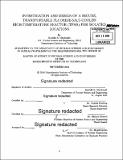Investigation and design of a secure, transportable fluoride-salt-cooled high-temperature reactor (TFHR) for isolated locations
Author(s)
Macdonald, Ruaridh (Ruaridh R.)
DownloadFull printable version (10.70Mb)
Alternative title
Fluoride-salt-cooled high-temperature reactor for isolated locations
TFHR for isolated locations
Other Contributors
Massachusetts Institute of Technology. Department of Nuclear Science and Engineering.
Advisor
Charles Forsberg.
Terms of use
Metadata
Show full item recordAbstract
In this work we describe a preliminary design for a transportable fluoride salt cooled high temperature reactor (TFHR) intended for use as a variable output heat and electricity source for off-grid locations. The goals of the project were to design an economic reactor: a) Sized for the average load of a site but able to increase output to provide peaking power. b) With safety, security and safeguard requirements met by the choice of materials and form as opposed to relying on security forces and infrastructure. Powering remote sites such as mining stations, military bases, communities or even large ships could be a significant long term market for small nuclear reactors. However, the design basis is very different. The increased cost of transporting goods to the site and maintaining a large population of specialists means a reactor must be simpler to operate and able to defend itself against attackers and proliferators without a large security force. On the other hand, the increased cost of electricity in remote places means more can be spent to meet these goals. This report discusses these issues of operating at a remote site and a general strategy for meeting the resulting design criteria. The TFHR design puts these decisions into practice. The TFHR described is a 125MWth, thermal spectrum reactor using SiC-matrix coated particle fuel which can achieve single batch discharge burnups of up to 70MWd/HMkg over an 8 year cycle. Higher burnups are possible for larger cores. The neutronics properties of SiC-matrix coated particle fuel are explored in detail and various means by which they can be incorporated into a reactor are detailed. The TFHR uses a nuclear air Brayton combined cycle (NACC) for electricity generation, adapted from an off the shelf GE aero-derivative gas turbine. The NACC incorporates a combustible fuel injection port between the high and low pressure turbines which can be used to raise the temperature of the working fluid and boost the power extracted from the system by up to 50%. This increase of electric output occurs without changing the power drawn drawn from the reactor, avoiding any transients. The ability to peak the power output removes the need for a second power system or for the reactor to be sized for the maximum power demand, which is a significant cost saving. However, using an air Brayton cycle requires a high temperature reactor. A TFHR is a better match for this purpose than a gas cooled reactor as it operates at atmospheric pressure, making it easier to meet the security goals described above.
Description
Thesis: S.M., Massachusetts Institute of Technology, Department of Nuclear Science and Engineering, 2014. Page 95 blank. Cataloged from PDF version of thesis. Includes bibliographical references (pages 67-70).
Date issued
2014Department
Massachusetts Institute of Technology. Department of Nuclear Science and EngineeringPublisher
Massachusetts Institute of Technology
Keywords
Nuclear Science and Engineering.